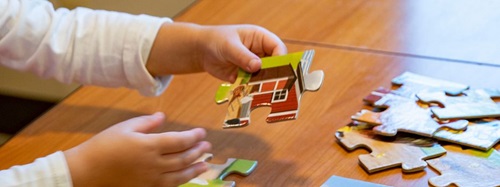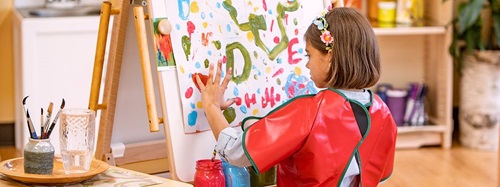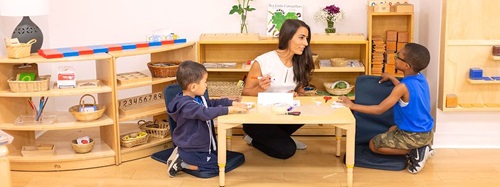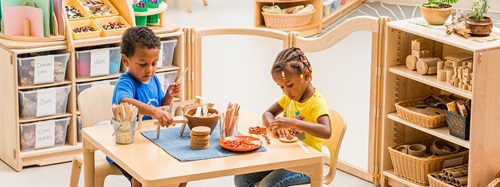Open Windows: Prime Times for Early Learning
| July 2010When we speak of “windows of opportunity,” I always visualize open windows that let in the fresh air and the newness of the outside world. In the early years of a child’s life, the greatest window is open for learning skills and abilities in all areas of development.
In this period, brain cells make connections that lay the foundation for all future learning, and these pathways must be maintained, through repetition and consistency, in order for the connections to be preserved. What is learned when the windows are wide open to the appropriate stimulation will most likely be learned adeptly and for a lifetime.
When you observe an infant or a three-year-old playing, you immediately see the learning that is happening as her brain cells make the connections necessary for growth and development. As an infant discovers her hands or a rattle, she uses all her senses to learn everything about that object. The three-year-old stacking blocks or making a puzzle uses eye-hand coordination and past experiences to accomplish the task.
Early childhood educators who have observed young children know that the early years are sensitive periods for young learners. “While learning continues throughout the life cycle, there are ‘prime times’ for optimal development – periods during which the brain is particularly efficient at specific types of learning.” (Shore, 1997)
Maria Montessori (1870-1952) called them “optimal periods,” and in her observations of children learned about the “absorbent mind.” As a forerunner in early childhood education, she set the standard for the infant, toddler, and pre-school classroom. She taught us that the “prepared environment” is important to learning, especially for children from birth to five years of age. In her observation of children, she was often heard saying “I studied my children, and they taught me how to teach them.”(Flaherty)
Today, new technology has given us a closer look into how the brain works, and society has begun to think differently about the importance of the early years. For over ten years now, brain researchers have told us about the windows of opportunity in early brain development. Investment into these early years now makes more sense because there is evidence of those windows and the wiring of the brain. As an educator and the program manager of an infant/toddler program, I studied this research and learned about the new insights into the wiring of the brain. It is both fascinating and informative.
The newborn’s world opens up to an avalanche of new sensations, thoughts, and feelings. As the infant begins to roll over, sit up, and crawl, then the toddler to walk and preschooler to jump and run, exploration in the environment becomes an avenue for learning which requires careful preparation.
In the home, parents quickly realize that they must child-proof their home and provide their child with the opportunity to explore, discover, and manipulate her world independently. Just like a classroom for early learners, it must not just be safe; it must be arranged and organized where a child is able to reach her own toys, books, blocks, paints, and other instructional materials that stimulate learning. Furniture and equipment should be child-size and developmentally appropriate for safety and comfort. During this time of intense mental activity and concentration on the development of skills and abilities in all areas of growth, the classroom and outdoor environment play a crucial role.
The appropriate physical environment for children from birth through five will encourage healthy growth in all areas of development.
Motor Development: Areas with opportunities for stepping up, pulling up, and climbing up promote upper and lower large muscle strength, control, balance, coordination and perception. These opportunities should be offered indoors as well as outdoors, using items such as duck ponds for infants, small carpeted platforms, foam-cushioned seats and steps and other furniture and equipment that will allow infants and toddlers to move and explore independently. Manipulatives, blocks, and puzzles also build fine motor skills.
Preschoolers (three- to five-year-olds) begin to master these large and small motor skills and spend their time fine-tuning them. They need many opportunities for painting, building with manipulatives, movement, dancing, climbing, jumping, skipping, and running, indoors and outdoors. Climbing structures, slides, steps, pedal pusher and trike paths and plenty of running space will encourage large motor development.
Social-emotional DevelopmentAreas with open low storage shelves, cruiser centers, shatter-proof mirrors, child-size tables, chairs, and sinks provide opportunities for independent play, hygiene, and rest. A child should be free to play individually, with a small group, or with a large group of peers. Both environment and learning materials should promote self-confidence, self regulation, and self-control, and teach social skills such as taking turns and sharing. Infants learn self-feeding and self-care skills, while toddlers and preschoolers learn life skills such as tying their shoes, serving themselves food, and brushing their teeth.
This is an opportune time to learn respect and empathy for others. It is also a prime time to obtain an awareness of aesthetics and instill a love for music, art, dance, and other artistic expressions.
Nature walks and trips to the zoo and museums are extensions of the classroom which open young minds. As independent learners gain these abilities, they serve as a stepladder for further learning and development of a strong self-concept.
Cognitive/Language Development: The environment should have areas which provide opportunities to increase thinking and grammar skills as well as vocabulary. Teachers can use instructional materials such as books, puppets, dolls, blocks, letters, and numbers to create conversations with early learners on a daily basis.
Routines such as feeding, diaper changing, and playtime offer optimal windows for developing cooing into babbling, then one to two words, then two- to three-word sentences, and finally into five or more sentences to express feelings and thoughts.
Toddlers and preschoolers play in the block, library, writing, listening, art, discovery, and drama centers, which enhances their literacy, numeracy, math, and science skills. Language is an emotional tie between a child and her primary caregiver. It is important to teach a child in her parent’s dominant language first, and then work on acquiring a second language using songs, finger-plays, and rhymes. The window for language acquisition opens at birth and closes around age eight.
The question may come to mind: Do the windows close when a child turns eight? I don’t believe a person ever stops learning, but the brain is never again as sensitive to learning as it is when the cells begin to connect at birth through the first five years. It is in the best interest of our young learners for us as educators and parents to make the most of this unique window of opportunity.
Tarraugh Flaherty, Maria Montessori (1870-1952) www.webster.edu/~woolflm/montessori.html
And www.dailymontessori.comis an excellent website to learn about the Montessori method.
Rima Shore, Rethinking the Brain; New Insights into Early Development, Families and Work Institute, 1997.






